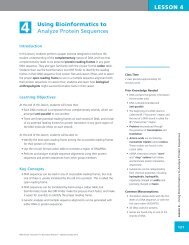WET LAB DNA Barcoding: From Samples to Sequences - Northwest ...
WET LAB DNA Barcoding: From Samples to Sequences - Northwest ...
WET LAB DNA Barcoding: From Samples to Sequences - Northwest ...
You also want an ePaper? Increase the reach of your titles
YUMPU automatically turns print PDFs into web optimized ePapers that Google loves.
<strong>WET</strong> <strong>LAB</strong><br />
CLASS SET<br />
Day 2 Procedure:<br />
The goal for Day 2 is <strong>to</strong> finish the <strong>DNA</strong> purification. The cell has been lysed, or broken open, on Day 1. Now you<br />
will need <strong>to</strong> separate the <strong>DNA</strong> from the rest of the cell debris.<br />
9. Make sure that the lid of your microfuge tube containing your sample is closed tightly, and vortex the tube<br />
containing your sample for 15 seconds.<br />
If you don’t have a vortexer, you can mix your tube by flicking it with your finger and tapping it on the table or<br />
lab bench <strong>to</strong>p, repeating every few seconds. However, if you don’t vortex your sample, you need <strong>to</strong> be sure <strong>to</strong><br />
mix it very well by hand for 1–2 minutes. The more you mix, the more <strong>DNA</strong> you will be able <strong>to</strong> purify.<br />
10. Add 700 μl of Genomic Lysis Buffer (labeled “Lysis”) <strong>to</strong> your sample, and mix thoroughly by vortexing.<br />
If you do not have a vortexer, you can mix your tube by flicking it with your finger and tapping it on the<br />
table or lab bench.<br />
This Genomic Lysis Buffer also contains detergents. On Day 1, you dissolved the cell membrane. Now you<br />
are dissolving the nuclear membrane that surrounds the nucleus, and the inner and outer mi<strong>to</strong>chondrial<br />
membranes <strong>to</strong> release the mi<strong>to</strong>chondrial <strong>DNA</strong>.<br />
Question 2. On a separate piece of paper or in your lab notebook, describe what your sample looks like.<br />
How <strong>to</strong> Load <strong>Samples</strong> in a Microcentrifuge<br />
When loading microfuge tubes in a microcentrifuge, always place the tubes with the hinge of the lid<br />
facing “out” or “up” (below, left). That way, when centrifugation is complete, the pellet will always<br />
be located on the outer-most portion of the tube (below, right). This is especially important when the<br />
pellet is small or hard <strong>to</strong> see.<br />
Wet Lab – <strong>DNA</strong> <strong>Barcoding</strong>: <strong>From</strong> <strong>Samples</strong> <strong>to</strong> <strong>Sequences</strong><br />
351<br />
©<strong>Northwest</strong> Association for Biomedical Research—Updated Oc<strong>to</strong>ber 2012
















